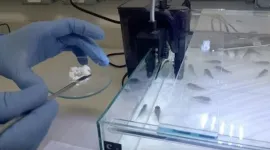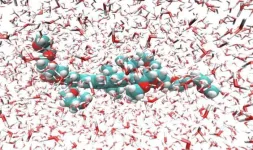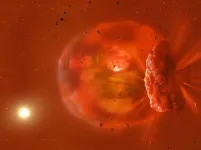(Press-News.org) A novel biomaterial developed at the Federal University of São Paulo (UNIFESP) in Brazil can help solve two problems at once. As a bioparticle, it can act as a drug carrier, delivering medication directly to the gastrointestinal tract of fish in order to circumvent resistance to conventional antibiotics, for example. In addition, it is administered orally in powder form and is highly palatable to fish, increasing the probability of effective treatment while at the same time reducing the waste and pollution inherent in the medication of these animals.
The research is reported in an article published in the journal Biomaterials Advances.
“Our bioparticle can pass through the digestive tract and deliver medication directly to the intestine, enhancing the efficacy of conventional drugs, which is increasingly impaired by bacterial resistance,” said Patrick D. Mathews, a co-author of the article. The research was conducted while he was a postdoctoral fellow at UNIFESP’s Medical School (EPM).
“The material can be administered directly in the water, where it is consumed by the fish. The normal delivery method entails mixing medication into feed, so you never know how much is actually consumed as opposed to just polluting the water. This has become a serious issue for large fish farming ventures such as Chile’s salmon industry,” said Mathews, who was recently awarded a Young Investigator Grant by FAPESP and will continue the research at São Paulo State University’s Botucatu Institute of Biosciences (IBB-UNESP).
The bioparticle is based on chitosan and alginate, polysaccharides of natural origin used in industry and research. Chitosan is derived from the shells of crustaceans, and alginate is derived from seaweed. The formulation also contains arginine, an amino acid present in most protein-rich foods. The antimicrobial molecule used was a peptide obtained from an arachnid found in Brazil’s Southeast region.
Specimens of Schwartz’s catfish (Corydoras schwartzi), an ornamental fish species native to the Amazon and other parts of South America, were treated with the biomaterial for eight days. Analysis of their intestinal tissue showed high penetration of the biomaterial into epithelial cells and deeper layers of the organ. Various histological methods failed to detect any cytotoxic effects or other damage due to the particle. Hematological tests confirmed the absence of toxicity in blood cells.
“We used materials known to have little or no cytotoxicity. Chitosan also has the advantage of adhering well to mucous membranes, as demonstrated in the study. The tests also showed that it tolerates digestive tract acidity and reaches the intestine intact,” said Omar Mertins, a professor in EPM-UNIFESP’s Biophysics Department and last author of the article.
The material resulted from two projects led by Mertins: “Improvement of the properties of the polysaccharide chitosan for its application in liposomes and giant vesicles” and “Crystalline-phase nano cubosome functionalized with biopolymers: development as a drug carrier and in vivo studies in zebrafish (Danio rerio)”.
Parasites
In a previous study, the researchers tested the efficacy of a similar formulation against parasites that infect the same fish species. The bioparticle delivered the anthelmintic drug praziquantel, widely used to treat diseases caused by parasitic flatworms (helminths).
“These and other ornamental fish are mainly exported to Asia, Europe and the United States, taking large number of parasites with them. The introduction of novel pathogens via these exports is a significant risk for ecosystems and even commercial production, as they can contaminate both wild and farmed species,” Mathews said.
In the intestines of the animals colonized by worms, the bioparticle penetrated the cysts built by the parasites for self-protection, demonstrating that the material can be used as a drug carrier to treat other fish species. An application has been filed for a patent on one of the formulations.
The researchers will now test this and other formulations to treat parasites in fish commercially farmed for human consumption, such as the Nile tilapia (Oreochromis niloticus) and the Tambaqui (Colossoma macropomum).
A study conducted in 2017 by another group of researchers estimated the annual loss to freshwater fish farming in Brazil due to disease at USD 84 million.
“The fact that the material is non-toxic to fish shows it isn’t harmful for humans who consume their flesh. The prospects for application are highly positive,” Mertins said.
About São Paulo Research Foundation (FAPESP)
The São Paulo Research Foundation (FAPESP) is a public institution with the mission of supporting scientific research in all fields of knowledge by awarding scholarships, fellowships and grants to investigators linked with higher education and research institutions in the State of São Paulo, Brazil. FAPESP is aware that the very best research can only be done by working with the best researchers internationally. Therefore, it has established partnerships with funding agencies, higher education, private companies, and research organizations in other countries known for the quality of their research and has been encouraging scientists funded by its grants to further develop their international collaboration. You can learn more about FAPESP at www.fapesp.br/en and visit FAPESP news agency at www.agencia.fapesp.br/en to keep updated with the latest scientific breakthroughs FAPESP helps achieve through its many programs, awards and research centers. You may also subscribe to FAPESP news agency at http://agencia.fapesp.br/subscribe.
END
Novel biomaterial delivers medication directly to fish gut
In addition to helping combat antimicrobial resistance, the bioparticle developed at the Federal University of São Paulo avoids the waste and pollution created by excessive amounts of drugs in water bodies.
2023-10-11
ELSE PRESS RELEASES FROM THIS DATE:
$15.4 million grant to help eliminate health disparities in Indiana
2023-10-11
INDIANAPOLIS—A new $15.4 million grant will help Indiana University School of Medicine recruit and educate medical students to better care for underserved populations, in hopes of improving health care across Indiana.
The Health Resources & Services Administration (HRSA) grant will provide about $4 million over four years to the Indiana Primary Care Advancement in Clinical Training (INPACT) program. The goal of the program is to recruit more students from medically underserved areas of the state and provide doctors with the tools ...
Aerovy, an advanced air mobility software provider, completes $800,000 pre-seed funding round
2023-10-11
WEST LAFAYETTE, Ind. – Aerovy, a Purdue University-connected startup, has completed a round of funding and is expanding industry partnerships around the world. Aerovy develops cloud-based software solutions for the advanced air mobility, or AAM, sector, which includes electric-powered urban and regional aircraft.
CEO Nick Gunady said Aerovy has closed its round of pre-seed funding, raising $800,000 from Purdue Innovates, M25 and the Flywheel Fund.
“The closing of the pre-seed round represents a critical milestone in our missions to unlock the energy ...
Absorption of light by molecules has applications in microscopy, medicine and data storage
2023-10-11
Absorption spectroscopy is an analytical chemistry tool that can determine if a particular substance is present in a sample by measuring the intensity of the light absorbed as a function of wavelength. Measuring the absorbance of an atom or molecule can provide important information about electronic structure, quantum state, sample concentration, phase changes or composition changes, among other variables, including interaction with other molecules and possible technological applications.
Molecules with a high probability of simultaneously absorbing ...
SwRI’s Dr. Nicholas Mueschke named AIAA Associate Fellow
2023-10-11
SAN ANTONIO — October 11, 2023 —Southwest Research Institute’s Dr. Nicholas Mueschke has been named an Associate Fellow of the American Institute of Aeronautics and Astronautics (AIAA).
AIAA Associate Fellows are recognized for overseeing important engineering or scientific work and outstanding contributions to their field. Associate Fellows must be recommended by at least three other associate fellows, be a senior member in good standing of the AIAA and have at least 12 years of professional experience. AIAA selects only one Associate Fellow for each 150 members each year.
The AIAA selected Mueschke for ...
New research finds greater continuity of psychotherapy after shift to telehealth
2023-10-11
WASHINGTON, D.C., Oct. 11, 2023 — The rapid transition to virtual care that occurred with the onset of the COVID-19 pandemic resulted in better continuity of psychotherapy visits compared to prior to the pandemic when almost all visits were in-person, according to new research published in Psychiatric Services, a journal of the American Psychiatric Association. In addition, the time between appointments grew shorter after the transition to virtual care. The study results highlight the benefits of continued availability of virtual psychotherapy.
This ...
Newsmakers: Basic research findings by Johns Hopkins scientists focus on gene sequencing, hearing loss and a brain disorder
2023-10-11
FOR IMMEDIATE RELEASE
Yes, Scientists Have Sequenced the Entire Human Genome, But They’re Not Done Yet
The human genome, from end to end, has been sequenced, meaning scientists worldwide have identified most of the nearly 20,000 protein-coding genes. However, an international group of scientists notes there’s more work to be done. The scientists point out that even though we have nearly converged on the identities of the 20,000 genes, the genes can be cut and spliced to create approximately 100,000 proteins, and gene experts are far from agreement on what those 100,000 proteins are.
The group, which convened last fall at Cold Spring Harbor Laboratory in New York, has now ...
Icahn School of Medicine at Mount Sinai and the University of California San Diego receive $8.5 million award to establish a data integration hub for NIH Common Fund supported programs
2023-10-11
New York, NY [October 11, 2023]—Researchers at the Icahn School of Medicine at Mount Sinai and the University of California San Diego have been awarded an $8.5 million grant to create a data integration hub aimed at accelerating novel therapeutics and cures for diseases within initiatives supported by the National Institutes of Health (NIH) Common Fund.
NIH Common Fund programs are large-scale projects designed to collect cutting-edge biomedical research data from human cells, tissues, and patients to rapidly ...
Warm summers and wet winters yield better wine vintages
2023-10-11
Wine quality is notorious for varying from year to year, but what makes for a “good year”? In a paper publishing October 11 in the journal iScience, researchers show that weather plays an important role in determining wine quality. By analyzing 50 years’ worth of wine critic scores from the Bordeaux wine region in relation to that year’s weather, the researchers showed that higher quality wine is made in years with warmer temperatures, higher winter rainfall, and earlier, shorter ...
Cleaner air brings a wetter high mountain Asia
2023-10-11
High Mountain Asia (HMA), encompassing the Tibetan Plateau and the surrounding Hindu Kush, Karakoram, and Himalayan ranges, harbors the world's third-largest amount of glacial ice. It is the source of more than 10 major Asian rivers and vital water resources for nearly 2 billion people.
Recent decades have witnessed a dipolar trend in HMA precipitation, characterized by an increase in the north but a decrease in the southeast. These changes have significant implications for water resource security and ecological equilibrium in both local ...
Researchers capture first-ever afterglow of huge planetary collision in outer space
2023-10-11
The study, published today in Nature, reports the sighting of two ice giant exoplanets colliding around a sun-like star, creating a blaze of light and plumes of dust. Its findings show the bright heat afterglow and resulting dust cloud, which moved in front of the parent star dimming it over time.
The international team of astronomers was formed after an enthusiast viewed the light curve of the star and noticed something strange. It showed the system doubled in brightness at infrared wavelengths some three years before the star started to fade in visible light.
Co-lead author Dr Matthew Kenworthy, from Leiden University, ...
LAST 30 PRESS RELEASES:
Exposure to wildfire smoke late in pregnancy may raise autism risk in children
Breaking barriers in lymphatic imaging: Rice’s SynthX Center leads up to $18 million effort for ‘unprecedented resolution and safety’
Dhaval Jadav joins the SETI Institute Board to help spearhead novel science and technology approaches in the search for extraterrestrial life
Political writing retains an important and complex role in the national conversation, new book shows
Weill Cornell Medicine receives funding to develop diagnostic toolbox for lymphatic disease
It started with a cat: How 100 years of quantum weirdness powers today’s tech
McGill researchers identify a range of unexpected chemical contaminants in human milk
Physical therapy research highlights arthritis’ toll on the workforce — and the path forward
Biomedical and life science articles by female researchers spend longer under review
Forgetting in infants can be prevented in mice by blocking their brain’s immune cells
Blocking immune cells in the brain can prevent infant forgetting
AI-driven ultrafast spectrometer-on-a-chip: A revolution in real-time sensing
World enters “era of global water bankruptcy”; UN scientists formally define new post-crisis reality for billions
Innovations in spatial imaging could unlock higher wheat yields
A twitch in time? Quantum collapse models hint at tiny time fluctuations
Community water fluoridation not linked to lower birth weight, large US study finds
Stanford University’s Guosong Hong announced as inaugural recipient of the SPIE Biophotonics Discovery’s Impact of the Year Award
Ice, ice, maybe: There’s always a thin layer of water on ice — or is there?
Machine learning lends a helping ‘hand’ to prosthetics
Noninvasive brain scanning could send signals to paralyzed limbs
Community water fluoridation and birth outcomes
SGLT2 inhibitors vs GLP-1 receptor agonists for kidney outcomes in individuals with type 2 diabetes
Long-term exposure to air pollution and risk and prognosis of motor neuron disease
Five-year absolute risk–based and age-based breast cancer screening in the US
Study finds elevated alcohol involvement in suicides of lesbian, gay and bisexual women
Air pollution may increase the risk of the neurodegenerative disease ALS
Chronic kidney disease poisons patients’ hearts, scientists discover
Hollings researchers reveal why some pancreatic tumors behave differently
DNA ties gut motility to vitamin B1
Study suggests pathway for life-sustaining conditions in Europa’s ocean
[Press-News.org] Novel biomaterial delivers medication directly to fish gutIn addition to helping combat antimicrobial resistance, the bioparticle developed at the Federal University of São Paulo avoids the waste and pollution created by excessive amounts of drugs in water bodies.




